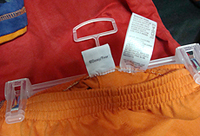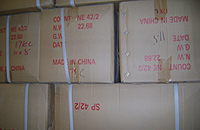 |
 Did you know... That CBP Sends Teams to Get a "Jump" on Fraudulent Imports?
(07/02/2012) International trade has been a major focus of CBP from its formation, and in the Homeland Security Act, the U.S. Congress required CBP to retain import and international trade specialist positions at the same level as the former U.S. Customs Service. For both CBP and the former U.S. Customs Service, a major concern has been the international manufacture of textiles and apparel. International trade has been a major focus of CBP from its formation, and in the Homeland Security Act, the U.S. Congress required CBP to retain import and international trade specialist positions at the same level as the former U.S. Customs Service. For both CBP and the former U.S. Customs Service, a major concern has been the international manufacture of textiles and apparel.  | click for hi-res
 | | Investigations of Textile Production Verification Teams also address intellectual property and truth-in-labeling issues. A Verification Team visiting Egypt in 2010 discovered this label which purports to be a Disney Pixar product. Not only is this crude label missing the Disney trademark logo, it also misspells Pixar. |
|
|  |  |
CBP’s work extends to manufacturing sites in foreign countries. To ensure that goods are consistent with their manufacturers’ labels and export documentation, CBP uses a complex program to identify and thwart illicit practices. One of the means to address fraudulent imports is the use of textile production verification teams. Originally known as jump teams, these teams take the investigatory practices to factories across the world. The U.S. Customs Service created “textile and apparel jump teams” in 1991 according to an Associated Press wire story published in October of that year.The term Jump Team is of uncertain origin. It has been suggested that it refers to their tactical ability to mobilize and address issues at their source through unannounced visits and inspections. In a speech before the 1992 annual convention of the North American Textile Manufacturers Institute, Customs Commissioner Carol Hallett noted that it referred to the ability to “jump into a situation.”  |  | click for hi-res
 | | Transshipment moves goods through another country. Transshipment becomes an illegal activity when it is used to circumvent quotas or duties. The thread in this Youm Kwang facility in Central America was shipped from China and dyed at the facility. The labels and export documentation claimed that the thread was “100% made in Guatemala.” The Jump Team discovered boxed thread with “made in China” printed on the containers, and the Guatemala facility had no capacity to manufacture the yarn. |
|
|  |  |
The first Jump Teams were originally joint ventures by the Commerce Department and the U.S. Customs Service. During their first years of investigations, they found wide-spread abuse. By March 1992, the jump team findings led to the closure of 191 of the 209 sweater factories listed as operating in Macau because they were “fronts for Chinese exporters.”The Macau factories were not manufacturing items as stated in their export documents. Most of the bogus factories were engaging in a practice known as illegal transshipment. This is when manufactured goods are shipped through another country to thwart U.S. import rules. In one case, there was no factory, only a post office box. Often time, illegal transshipments occur to take advantage of preferential tariff treatment as negotiated in free trade agreements. In 2010, CBP traveled to the Youm Kwang facility in Guatemala after receiving affidavits stating it produced thread. The Textile Production Verification Team found thread that was manufactured in China and was dyed at the facility. Its labeling claimed that it was 100 percent manufactured in Guatemala.This nefarious practice continues, and the Textile Production Verification Teams still investigate illegal transshipments. During their visits, the teams tour factories, interview senior management and review production records in an attempt to verify that merchandise is actually made in the factories and complies with all U.S. import regulations. Their work enforces international trade agreements, protects American jobs and ensures that product labeling is accurate. |
 |
|  |  |
 |